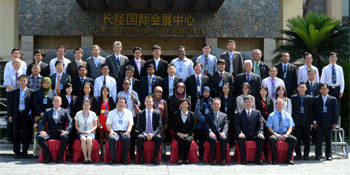For use of the media only;
not an official document.
Geneva/Guangzhou, 14 May 2012 – The development and use of CITES e-permitting systems, and their role in ensuring legal, sustainable and traceable international trade in CITES-listed species, was discussed by countries in Asia at a meeting in Guangzhou, China on 9 to 11 May 2012.
The rapid advances by some countries in the Asian Region on use of new electronic trade standards, including the establishment of ‘Single Windows’1, assisted participants in discussing joint projects on the establishment of secure-permitting systems to: reduce fraud; improve on meeting reporting obligations; enhance permit issuance and administration; and provide up-to-the-minute data to assist with CITES scientific assessments (non-detriment findings and significant trade reviews).
-

- A group photo of the participants to the e-permitting meeting. Click to see
a larger photo.
The meeting was jointly organized by the CITES Secretariat and the Government of China and made possible through the generous financial support of China and the European Commission.
The Asian Region also benefits from the framework provided by the Association of South East Asian Nations (ASEAN) whose member countries have agreed to implement an ASEAN Single Window, which will create a simplified, standardized and integrated environment for cargo clearance in line with international best practices and norms2.
Participation in the meeting by representatives from: Brazil and Namibia; the UNEP-World Conservation Monitoring Centre; the World Customs Organization (WCO), and the Chair of the CITES e-permitting working group, offered participants the opportunity to plan innovative projects. This included making use of South-South collaboration, as well as the unique expertise available in the participating countries and international organizations. Brazil, for example, has offered to make its know-how freely available to countries in the Latin American Region and in other regions that are planning to implement CITES e-permitting systems.
Ms Yin Hong, Vice Administrator of State Forestry Administration and Director General of the Endangered Species Import and Export Management Office of China stated, “China is pleased to work together with Parties to CITES, international organizations and the CITES Secretariat to push forward the development of technologies to strengthen the protection of CITES species and to better regulate trade, enhance law enforcement and make greater contributions to sustainable social and economic development. ”
In his opening remarks, Secretary-General, Mr. John E. Scanlon, noted that, “A sustainable future is being discussed in the context of the upcoming United Nations Conference on Sustainable Development, to be held in Rio de Janeiro in June of this year, often known as Rio+20. Sustainability is not achieved through one action but through the accumulation of multiple actions. Actions such as those being taken today - namely to put into place e-permitting systems for legal, sustainable and traceable trade in CITES listed species - help build the essential foundations for environmental sustainability and sustainable development. E-permitting systems offer us one of the tools we need to reach the future we want.”
During the meeting, a representative of the WCO announced the successful conclusion of an initiative to include standards of the CITES e-permitting toolkit with the new version of the WCO Data Model, scheduled for release in October 2012. In his announcement, Mr Sybrand Bootsma, WCO Technical Officer, declared, “The joint achievement by the CITES Secretariat and the WCO will make it easier for CITES Parties to develop e-permitting systems that are fully harmonized with international standards and to Single Windows. It also paves the way for other multilateral environmental agreements to make use of the framework provided by the WCO data model.”
Participants in the meeting also focused on the positive impacts of CITES e-permitting systems on the provision of up-to-the-minute data for scientific findings and reviewing levels of trade. During these discussions, Mr Mathias Löertscher, Chair of the Working Group on CITES E-permitting and Head of the CITES Management Authority of Switzerland, stated, “CITES e-permitting systems will strengthen the science base of the Convention by providing the scientific community with data that can be used to better monitor CITES-listed species in the wild and can be combined with other datasets for the development of more relevant biodiversity indicators.”
The meeting concluded by recommending a number of bilateral and regional projects, which will assist Parties to plan and develop e-permitting systems, benefiting from lessons learned. Recommendations were also made to begin discussions on a project between Brazil, Namibia and China on using new e-permitting technologies to ensure legal, sustainable and traceable trade.
Note to editors: For more information, please contact Marcos Silva at +41 22 917 8120 or marcos.silva@cites.org
![]()
1. A Single Window is defined as a facility that allows parties involved in trade and transport to lodge standardized information and documents with a single entry point to fulfil all import, export, and transit-related regulatory requirements. If information is electronic, then individual data elements should only be submitted once (Recommendation and Guidelines on establishing a Single Window to enhance the efficient exchange of information between trade and government (United Nations Centre for Trade Facilitationand Electronic Business (UN/CEFACT), Recommendation No. 33).
2. Agreement to Establish and Implement the ASEAN Single Window, Kuala Lumpur, 9 December 2005 (http://www.aseansec.org/18005.htm)
![]() To read previous press releases, go to Archives.
To read previous press releases, go to Archives.